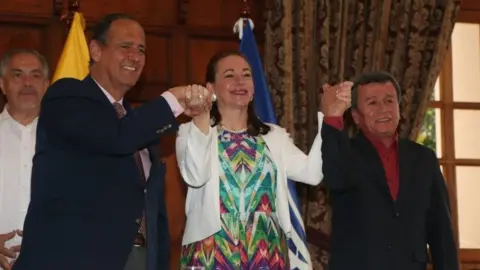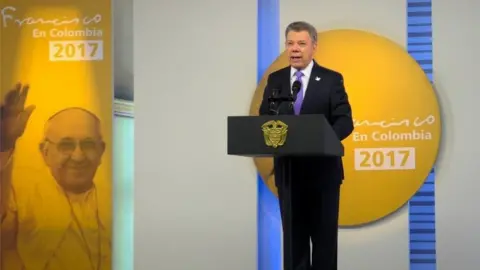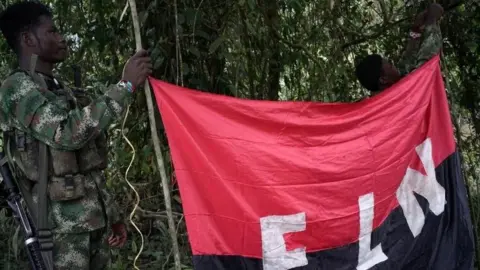Colombian government and ELN rebels agree ceasefire
 EPA
EPANegotiators from the National Liberation Army (ELN) rebel group say they have agreed a temporary ceasefire with the Colombian government.
It is the first time the two sides have agreed a ceasefire in more than 50 years of conflict.
The announcement comes less than 48 hours before Pope Francis is due to visit Colombia.
Colombian President Juan Manuel Santos said the truce would begin on 1 October and would last until 12 January.
In a tweet in Spanish, the ELN wrote: "Yes we could! We thank all of those who backed our efforts to reach this #BilateralCeasefire."
Allow X content?
And in another statement, the rebel group said that "the visit of Pope Francis should provide extra motivation to speed up the search for an agreement".
 AFP/Getty Images
AFP/Getty ImagesMeanwhile, President Santos said in a televised speech that the "the priority is to protect citizens, so during this period, kidnappings, attacks on oil pipelines and other hostilities against the civilian population will cease".
He added that there was a chance the ceasefire, which would initially last for 102 days, could be extended beyond its current deadline.
The government in turn reportedly has agreed to improve the conditions of jailed ELN rebels and to boost the security of activist leaders, a growing number of whom have been killed in recent months.
The negotiations in Ecuador's capital Quito started in February - just months after the Colombian government and the country's biggest rebel group, the Revolutionary Armed Forces of Colombia (Farc), signed a peace deal. The Farc has since become a political party.
The ceasefire between the smaller ELN and the government was reportedly reached after all-night negotiations.

Will local commanders heed the ceasefire?
Natalio Cosoy, BBC Mundo, Bogotá
It might not make much of a difference to people living in the main Colombian cities, such as Bogotá or Medellín, but for those living in ELN rebel strongholds, news of the ceasefire will certainly bring hope.
 Reuters
ReutersIf the rebel group does stop kidnapping, blowing up oil pipes and targeting civilians, it will come as a huge relief to people in the most affected areas in the provinces of Arauca and Norte de Santander in the east, and Chocó, Nariño and Cauca on the Pacific Coast.
But with the ELN not having the same hierarchical structure as the Farc, the big question is whether ELN commanders on the ground will follow the agreement reached by the negotiators in Quito.

The ELN is believed to have fewer than 1,500 active fighters, according to intelligence reports seen by Colombian media.
They are backed up by a larger number of "militants" or sympathisers who provide logistical support and back-up.
Its strongholds are in rural areas in the north and on the border with Venezuela, and also in the provinces of Casanare, Norte de Santander and Cauca.
Negotiations have at times proved frustrating for the government, which has demanded that the group stop kidnapping people.
The ELN finances its operations mostly with the ransom paid to release hostages.
Last weekend, the ELN revealed that it had killed a Russian-Armenian hostage it was holding back in April.
